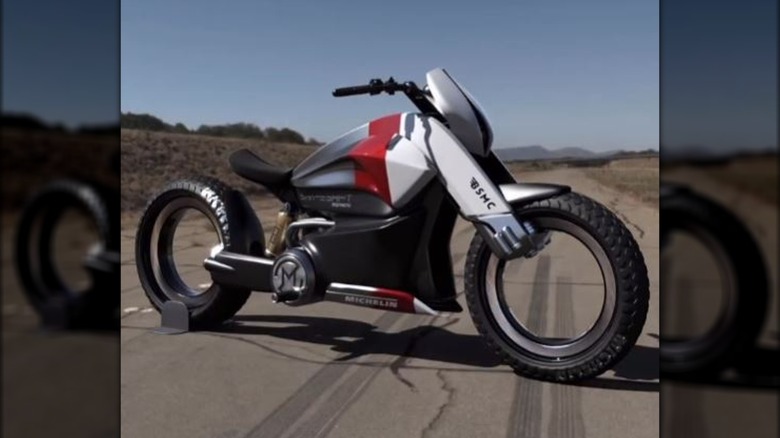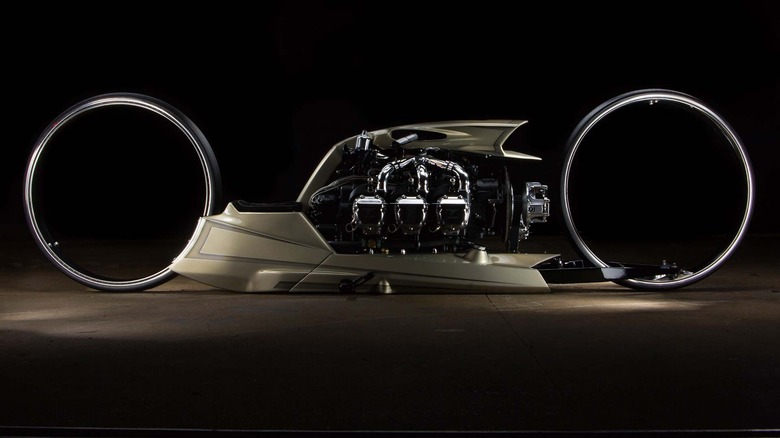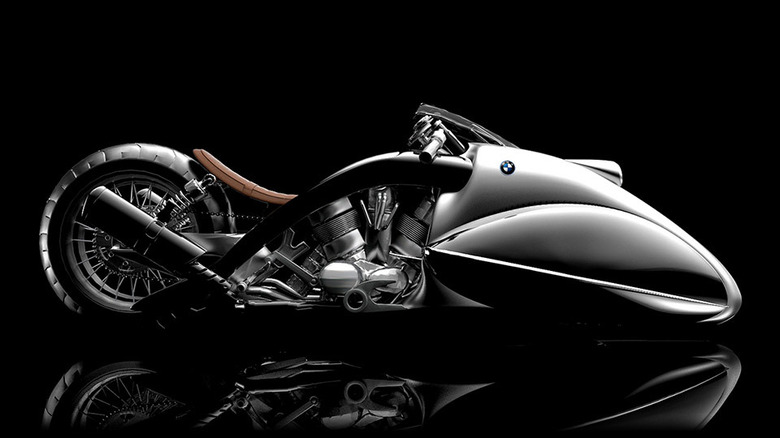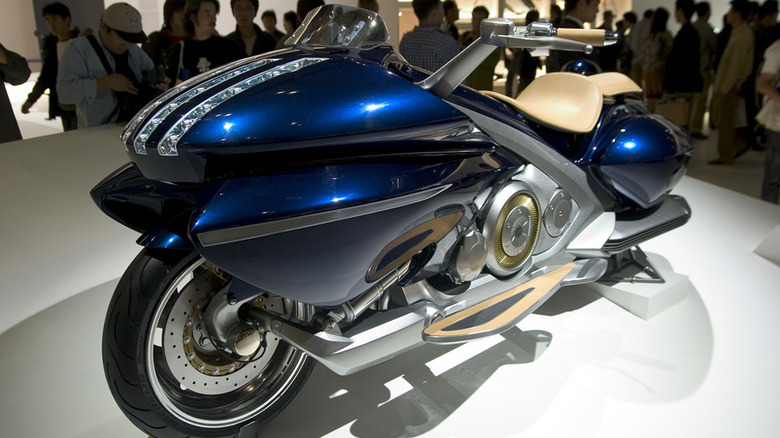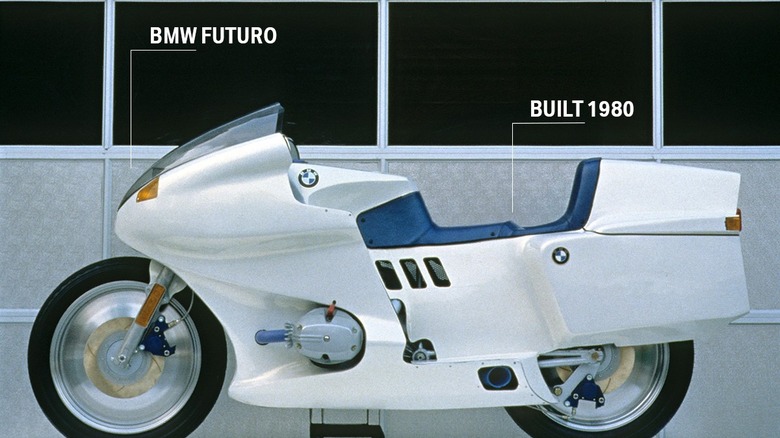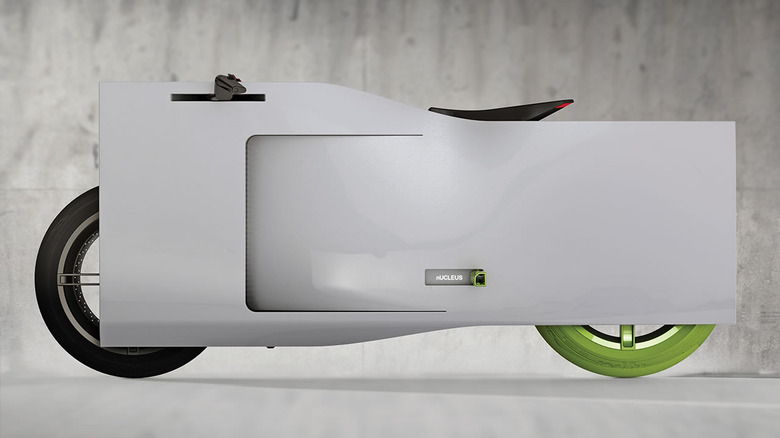6 Of The Strangest Concept Motorcycles Ever Developed
Handlebars, a seat, two wheels, and a motor – the recipe to create a basic motorcycle has long been a very simple one. Much like with cars, the concept of a two-wheeled vehicle has been firmly established for decades, so rather than reinventing the proverbial wheel, the goal of automotive manufacturers has been to iterate and innovate on what already works.
For the most part, that just means newer parts, updated features, improved safety standards, and so on. But for some motorcycle makers, the daily grind simply isn't enough. Through the creation of concept motorcycles, some creatives seek to challenge the public consensus of what a motorcycle can be, changing the silhouette, the features, and the very notion of two-wheeled transport. Granted, most of these dream bikes never actually see a real road, but the mere existence of their concepts serve as a fascinating delve into the strange and abstract of the motorcycle world.
ZiggyMoto Shift
If there's one thing any longtime fan of the heroes of TV and film can appreciate, it's a transforming vehicle. It's not enough to have one sleek-looking motorcycle, you need one that can completely reconfigure itself on the fly to accommodate all kinds of driving situations. One such concept came from the mind of Paul Drake, known online as ZiggyMoto, The Imaginary Motorcycle Company.
In 2023, Drake unveiled an unnamed CGI concept for a transforming motorcycle, which would come to be known as the Shift. In its default state, this motorcycle resembles a traditional café racer, but with a flip of a switch, its entire profile shifts. The body raises or lowers, and the tires sprout all-terrain bumps, transforming the bike into a highway cruiser or a rugged dirt bike in just a few seconds. The Shift motorcycle was never able to move past the CGI concept stage, though it still made quite the impression on onlookers when Drake showed a mockup of it at the London Bike Shed Moto Show that year.
TMC Dumont
It's a generally accepted notion that the wheels of a motorcycle are supposed to go beneath it. They're the part that touches the ground, after all. But to retired Formula 1 driver and automotive maker Tarso Anibal Santanna Marques, that notion was more of a casual suggestion than a requirement, one that he immediately discarded with the creation of his personal passion project, the TMC Dumont.
Starting with a bizarre inverted design, Marques then mounted the massive engine of a Rolls-Royce Continental to the top, blessing the bike with a mighty 300 horsepower. Marques created exactly one of these vehicles for himself, which was showcased on the road during Daytona Beach Bike Week 2018, where it won several awards. While the 36-inch hubless wheels are frighteningly low to the ground, the profile is incredible to view from the outside, looking as though it were gliding across the pavement.
BMW Apollo Streamliner
Here's something every motorcycle enthusiast has probably idly wondered at least once: "What would happen if you strapped a rocket to a motorcycle?" In real life, probably something very bad, but with a bit of creativity, you can get within spitting distance of the idea. For instance, could you create a bike designed exclusively with speed in mind, something rocket-like without actually strapping a rocket to it? The answer is yes, more or less, and that answer came about in the form of the BMW Apollo Streamliner.
Conceptualized by industrial designer Mehmet Doruk Erdem, the Streamliner was designed for one thing and one thing only: going fast on salt flats. While the rear and middle of the bike are fairly normal, notwithstanding the exposed engine and shocks, the front is what draws the eye. The Streamliner's front is covered by a large shroud which resembles the angled nose of a bullet train. This shroud is designed to slice through the wind and ensure the highest possible speed. Of course, since it's so low to the ground, even a slight bump would send the vehicle toppling, which is probably why it was never actually assembled.
Yamaha Gen-RYU
Alongside electric cars, electric motorcycles have gradually been making themselves known in the automotive world, seeking to bring the same kind of freedom and muscle you'd expect from a bike without all the exhaust. However, automotive makers have been tinkering with the idea of a motorcycle powered at least partially by electricity for decades, with one notable example being Yamaha's Gen-RYU concept.
Originally unveiled at the 2005 Tokyo Motor Show, this smooth number looks almost like something you'd find with a Batman action figure on at the toy store, and has the bells and whistles to match. The main attraction of the Gen-RYU was its continuously variable transmission, which allowed it to switch on the fly between its traditional gas motor and an internal electric battery. In addition to that, the Gen-RYU possessed several early versions of smart features that are common on current vehicles, like voice-activated navigation, a vehicle distance warning, hands-free cell phone pairing, and more. The Gen-RYU could be considered a precursor to many modern motorcycle design paradigms.
BMW Futuro
A motorcycle doesn't look like it'd be that hard to put upright in the event it falls over, but in actuality, most bikes are exceptionally heavy, enough to be difficult to just prop up. This is one of the reasons that good physical strength is vital for riders. What if, however, someone were to make a motorcycle out of lightweight materials that anyone could theoretically lift up with minimal effort? Well, then you'd have the BMW Futuro, a bike from the 80s that, while overshadowed by other major releases at the time, may have had more impact on automotive history than you'd think.
Developed in tandem with car customizer Buchmann, the Futuro was unveiled at the Cologne Show in 1980. While primarily an attempt to keep BMW's Boxer engine in the scene, the Futuro is considered by some to be an ancestor of the modern concept bike thanks to its convenient features. One such feature was its weight; thanks to the Kevlar carbon fiber that made up its fairing, the Futuro only weighed around 400 pounds, nearly half the weight of a typical motorcycle at the time. In addition to its relatively light weight, the Futuro also featured various electronic information meters, a novel concept that would go on to become an industry standard.
Nonobject nUCLEUS
If you looked at most of the motorcycles on this list, you would be able to immediately recognize them as motorcycles. Even the strangest concept motorcycle still looks like a motorcycle for the most part, with perhaps one notable exception: the nUCLEUS, created by design firm Nonobject. This thing looks less like a bike, and more like a little piece of a wall that sprouted wheels.
Originally unveiled in 2008, the nUCLEUS was touted as the next big evolution in two-wheeled travel, with a rider response system that was designed to seem almost alive. At the rider's touch, the nUCLEUS would lower itself to the ground to accommodate easy mounting, then raise up as it prepares to take off. The nUCLEUS also features an internal vent designed to funnel air right through its middle, to better accommodate its decidedly non-aerodynamic shape. Seems like that would be more easily remedied by just not making it a box, but points for a creative solution.

